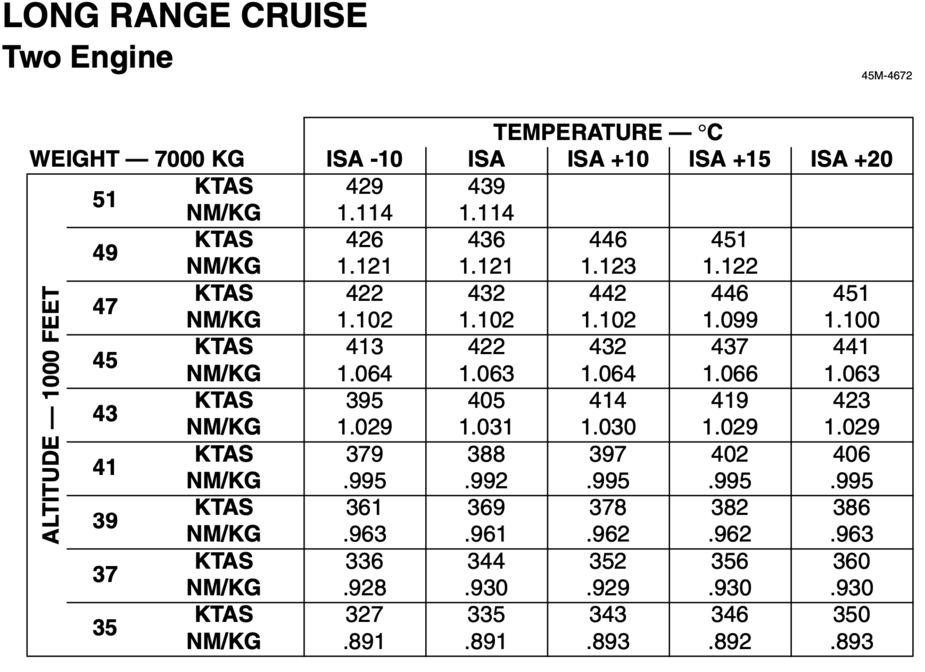Peter wrote:
Getting back to this, does colder air give you more MPG, at a given altitude?This post by @nobbi suggests it probably does not.
ISA variations cause a difference in speed when flying constant mach number, but they don’t cause a difference in fuel economy.

Peter wrote:
does colder air give you more MPG, at a given altitude
Lower temperature at a given Pressure altitude means a lower Density altitude and a lower TAS for a given engine HP.
Whether you keep that new TAS at the current FF, or increase HP/FF to maintain the TAS, this should yield a lower fuel efficiency/mpg.
Scanning through my library of POHs, some show the impact of weight only for take-off and landing, or only for climb, or some combinations.
Only Mooney POHs show the impact of both temperatures and weight on almost every performance chart, the best being the 252 where it’s on exactly every chart.
I also find it more cumbersome to determine on POHs with only performance tables with a few discrete temperatures. Much easier to interpolate with charts.
I doubt it. At the same power setting in a piston aircraft, in colder temperatures you see a higher indicated airspeed, but lower TAS. Since at the same power setting you should be able to have the same fuel flow, it stands to reason that although you will see faster indicated airspeeds, your true airspeed and specific fuel consumption per NM will be higher. So at least you feel better about actually going slower. :)
Fantastic thread!
Thanks so much for the dialog. Unbelievably good stuff!
From flying in Florida, I somehow suspected that my aircraft was more efficient in warmer weather and I had someone tell me that it wasn’t, but this lays that pancake out!
Massive improvement, considering long distance cruise and the other little games we play to gain just a few tenths difference in fuel flows.
Now to make a flight planner that also takes this into consideration (along with winds and all other manner of goodness)… (I’m volunteering someone else, in case that is ambiguous ;)
Peter wrote:
You would appear to be saying that the peak EGT fuel flow does vary with temperature at a given pressure altitude. That in turn causes the power variation.
If the inlet pressure is that atmospheric pressure, eg the throttle is wide open, then yes I believe so. At a higher ambient temperature, less air mass in the cylinder means less fuel can be burnt, you will have to lean more, and will produce less power at a lower fuel flow.
But this all relates to maximum power. If you throttle back, inlet air pressure and temperature should be used in the formula. The power you get for a given MP should then vary inversely with the square root of inlet temperature, but the (properly leaned) fuel flow should still be directly proportional to that power.
DavidS wrote:
Over the last few days I have been trying to explain the non-density effects in those C172 POH max climb tables I mentioned, and I can now reproduce the tables to within 30fpm. But I could only make it work if I had power vary with the square root of temperature, actually 1/sqrt(T), everything else held constant….
Great post! Thanks!
Not for the same fuel burn
You would appear to be saying that the peak EGT fuel flow does vary with temperature at a given pressure altitude. That in turn causes the power variation.
Peter wrote:
So… have I got it right that, using the small change approximation, a 1% increase in absolute temperature (i.e. an increase of 2.7 degC) would reduce power by 0.5%?
Yes that would be correct, with pressure and RPM held constant.
Peter wrote:
So a change from ISA to ISA+17 would reduce power by 3.1%. That is for the same fuel burn.
Not for the same fuel burn, I’m afraid. Ultimately, all engine power must come from the chemical energy in the fuel. Ordinarily, getting enough fuel into the cylinders does not limit us, but getting enough air into the cylinders can. At altitude, in a normally-aspirated WOT climb, the ambient pressure and temperature limit the mass flow of air through the engine, which in turn limits the rate we can burn fuel at, which limits our climb rate.
What an absolutely brilliant post, @DavidS! Many thanks.
I have edited your post to add locally stored copies of the docs, in case they disappear, which is sure to happen.
So… have I got it right that, using the small change approximation, a 1% increase in absolute temperature (i.e. an increase of 2.7 degC) would reduce power by 0.5%?
So a change from ISA to ISA+17 would reduce power by 3.1%. That is for the same fuel burn.